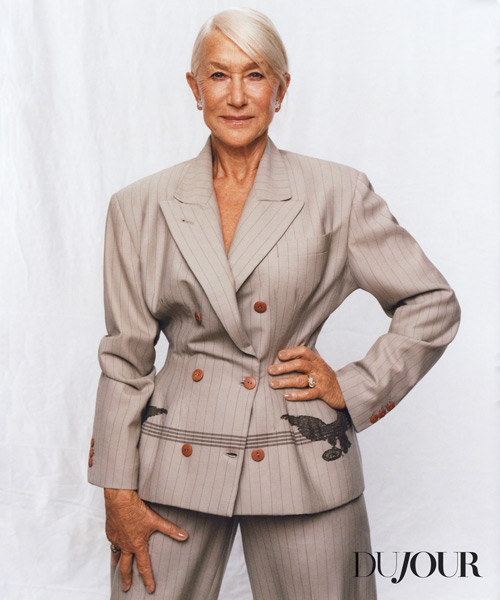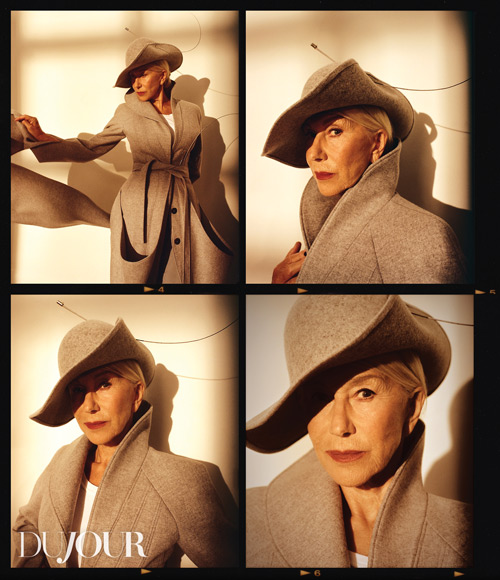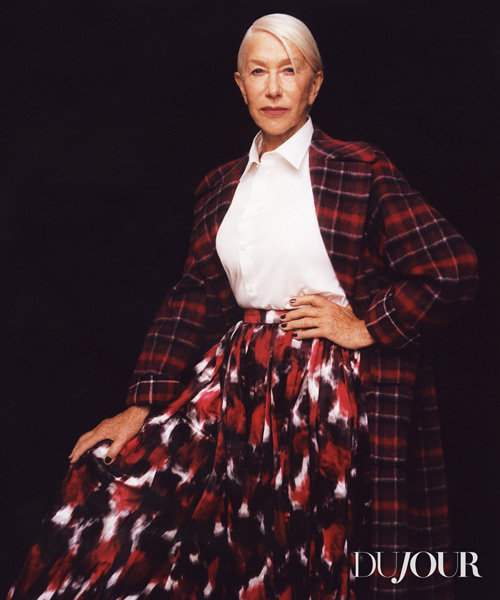Helen Mirren’s Prime Time
by Natasha Wolff | August 22, 2023 8:22 am
When Dame Helen Mirren was 12, her family took her to see an amateur production of Hamlet by the Southend Shakespeare Company in Essex.
“It must have been terrible and I didn’t really understand it, but the whole experience was a revelation,” says Mirren. It was her first real exposure to the theater, and it made her realize she needed to be an actor.
“The play, the lights going down, the amazing story being told, the complexity of the dialogue—it all just exploded in my mind, the way things can do when you’re a prepubescent teenager,” she recalls.
When Mirren got home, she started reading a set of the complete works of Shakespeare that her parents had in the house. “You know those books where there are thousands of pages and the print is really tiny?” she says. “I found that and started reading about these incredible characters, from Caliban to Queen Margaret.”
Shakespeare, she adds, is a “lifetime of work” and has perhaps become her own lifetime of work. “Even then, it’s the great wonder of Shakespeare that you never quite get to the end of it. I’m a great believer that Shakespeare shouldn’t be read until you’ve seen it. I still love to go.” She estimates that she’s seen A Midsummer Night’s Dream at least 10 times and has played nearly every role, from Titania, the queen of the fairies, to both young lovers Helena and Hermia.

That Mirren can slip into nearly any role is a testament to her incredible flexibility as an actor. In her decades of work, Mirren has won a Tony, an Oscar and five Emmys. Now 78, she has been a Calendar Girl, a detective (on television’s Prime Suspect, before doing television was cool), a faithful servant (2001’s Gosford Park), and the Irish wife of a ranch hand (on Paramount Plus’ Yellowstone spin-off 1923, opposite Harrison Ford). She’s been an action star (2010’s Red) and a cockeyed narrator for a famous doll (this summer’s Barbie), as well as a vast number of real-life individuals, including Alma Reville, aka Lady Hitchcock; Catherine the Great; Hollywood gossip columnist Hedda Hopper; Queen Elizabeth I; and Queen Elizabeth II. It was the latter of these that won her the Oscar, for 2006’s The Queen, and the Tony, for 2015’s The Audience.
This fall, Mirren takes on yet another world leader: Golda Meir, the first and only female head of the Israeli government. The film, Golda, directed by Oscar winner Guy Nattiv, follows Meir during the 19 days of the Yom Kippur War in October 1973.
Mirren, who is not Jewish, has been criticized for taking on the role. She has called the controversy “utterly legitimate.”
“It was certainly a question that I had, before I accepted the role,” Mirren told the Daily Mail last year. “I said, ‘Look Guy, I’m not Jewish, and if you want to think about that, and decide to go in a different direction…I will absolutely understand.’”
Nattiv says the idea to cast Mirren as Meir originated with the late politician’s grandson Gideon. “And it’s a brilliant idea,” Nattiv says. “Helen has the perfect combination of an authoritative, commanding figure but also this huge well of emotion and humanness. I’d live in any country that chose Helen as their prime minister.”
As for Mirren’s own interest in the role, “It’s an incredible challenge to play someone who was alive and well known,” she says. “Women in positions of great power are rare in history. There’s not many of them. I think they have to be twice as good as any man—or even 10 times. It’s absolute, total commitment. Golda had it. Catherine the Great had it. Elizabeth I had it. Elizabeth II did, too. There’s no casualness about their approach.”
Besides, Mirren continues, life is always more interesting than fiction. “You find extraordinary eccentricities and complexities,” she says. “Real characters are much denser than any sort your imagination can produce. Any person you meet at a bus stop has more in their life story.”
In preparing to take on a role, Mirren says she does a certain amount of research—but not too much. For her role as Clara Dutton in 1923, she read autobiographies of pioneer women in the American West. “But I’m terribly lazy about preparation,” she explains.
What to Mirren is laziness is complete submersion to her fellow actors. “Her concentration is absolute,” says French actress Camille Cottin, who plays Meir’s longtime assistant Lou Kaddar. “Every inch of her body turns into the character. She tells so much with her eyes. I loved her patience, her calm energy, and I greatly admired how easily she could switch from her character to herself again.”

Mirren’s physical transformation into Meir was equally remarkable. The politician—who smoked more than 80 cigarettes a day, including in her hospital bed, and died of cancer in 1978—had a very specific look. Thanks to the use of prosthetics, Mirren, who plays Meir around age 75, a few years before her death, looks older and wearier in the film than her own offscreen years.
“We went through various manifestations; going further, taking pieces away,” recalls Mirren. “Eventually we got to a point where we felt it was sufficient but hopefully not too much. With that sort of makeup, you’re wandering into dangerous territory. Obviously, it’s there and you can’t say it’s not there. But on the other hand, the audience knows I’m not an Irish woman living in Montana.”
During the two to three hours she spent daily in the makeup chair, Mirren would meditate on the character and listen to Meir’s many speeches. Mirren loved becoming this woman, she says, wrinkles and all: “I’ve never done anything like that before. It was an adventure. I got so used to being that person in the daytime that when the makeup all came off and I saw myself as I am, I’d forgotten that was what I looked like. It’s that acting thing—am I becoming her or is she becoming me? There’s a picture the crew made of me and Golda, and we’re in identical outfits. She’s turning to me and saying something, and I’m looking forward with a cigarette. It’s really powerful.”
Nattiv says that he never saw Mirren out of costume during the whole shoot. “She was Golda. Working with her was a dream come true.”
Mirren says her desire to act has ebbed and flowed over the years. “You’re so driven when you’re young, and as time goes on, you don’t have the same mad drive and desire.” The anticipatory anxiety before playing a character doesn’t get worse, she adds, but “it certainly doesn’t go away.”
“It’s a leap into the unknown each time,” she says. “You’re having to create a new family, a new set of relationships. You don’t know if the elements are going to come together. You’re cooking a meal, but without a recipe.”
Still, Mirren adds, “I’m always very excited if I’m being asked to do something I’ve never done before. It’s a fear and a thrill at the same time, like going on a bungee jump.”
When she was offered her role in 1923, there was no script, but the prospect of working with Ford and series creator Taylor Sheridan was exciting, as was being part of the Yellowstone universe.

“It’s soap opera in the best possible sense, like War and Peace. It’s this huge trajectory of American history through the eyes of a family,” she says. “The best literature is great soap opera.”
That role also gave Mirren the opportunity to do something new: drive a buggy. “It’s both easier and more difficult than it looks,” she says. “It all depends on the horse. I’ve never really understood horses, but I got to understand them a bit better. They’re unpredictable and predictable at the same time. They’re funny. They make me laugh.”
Having been married to the filmmaker Taylor Hackford for 25 years has given Mirren even more comfort on film sets. “It’s put me very much on the director’s side, doing my absolute utmost to make the director’s life bearable and to fulfill my actor’s end of the bargain,” she says. “I have a much greater sense of patience.”
She directed a short film in 2001 that made her want to direct more herself, but, “at my heart, I’m an actress. To become a director, I’d have to stop acting, and I didn’t want to give up my acting career. I’m blown away by people who act and direct. I don’t know how they do it.” As she explains it, she appeared in one scene in her short “and I found it almost impossible to concentrate on acting, which takes all of your imagination, while at the same time being practical about where the camera is. I couldn’t do it.”
Instead, she siphons much of her extra energy into gardening, whether it’s at home in the U.K, in Lake Tahoe, where she lives with Hackford, on set or in a hotel room—wherever there happens to be an opportunity.
“It’s meditative,” she says. “It’s a huge body of knowledge which I don’t have and I’m always trying to add to. The beauty of nature is so fantastic. It’s wonderful to watch something grow that you’ve taken a cutting of. My husband is a tree person, and I’m bushes and flowers. It’s a classic division of labor. It’s amazing to see trees we’ve planted.”
“I think gardening probably helps me be a better actor,” Mirren explains. “It kind of cleans your brain. You can’t have an ego with a garden. The fucking plant just won’t grow where you want it to grow. It’s good for an actor to have the cobwebs and ego and insecurity go away for a little.”
Helen Mirren participated in this cover shoot and interview in June before the SAG-AFTRA strike.
Hair: Charley McEwen
Makeup: Neil Young
Manicure: Lucy Tucker
Seamstress: Siobhan Dillon
Producer: Catherine Gargan
Source URL: https://dujour.com/culture/helen-mirren-golda/